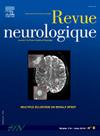Hyperoxemia and its impact on in-hospital mortality in intracerebral hemorrhage patients: A retrospective cohort study
IF 2.3
4区 医学
Q2 CLINICAL NEUROLOGY
引用次数: 0
Abstract
Introduction
This study aims to explore the relationship between arterial partial pressure of oxygen (PaO2) and in-hospital mortality in patients admitted for the first time with intracerebral hemorrhage, with emphasis on the effect of hyperoxia on mortality.
Methods
We screened the MIMIC IV database for 1985 patients with cerebral hemorrhage admitted for the first time between 2008 and 2019. Exclusions included cases with duplicate records, patients with tumors, aneurysms, traumatic cerebral hemorrhage, cerebral hemorrhage due to blood disorders, and cases missing PaO2 values — 828 patients for final analysis. Based on PaO2 levels within 24 hours of admission, patients were divided into three groups: high (> 150 mmHg), medium (100–150 mmHg), and low (< 100 mmHg). A logistic mixed-effects regression model was used to analyze the relationship between PaO2 and hospital mortality.
Results
The overall mortality rate during hospitalization was 37.1%. After adjusting for confounding factors, the mortality risk ratio (OR) of the low PaO2 group and high PaO2 group were 1.78 (95%CI: 1.04–3.03, P = 0.034) and 2.09 (95%CI: 1.28–3.42, P = 0.003), respectively. However, no significant associations were found between PaO2levels and 28-, 60-, or 90-day mortality. Subgroup analysis showed an interaction between in-hospital mortality and PaO2 level in patients with chronic lung disease (P = 0.002). Sensitivity analysis showed that the relationship still existed after excluding extreme PaO2 values.
Conclusions
Elevated arterial oxygen tension within the first 24 hours of admission was independently associated with increased in-hospital mortality in patients with intracerebral hemorrhage.
高氧血症及其对脑出血患者住院死亡率的影响:一项回顾性队列研究
前言:本研究旨在探讨首次入院脑出血患者动脉血氧分压(PaO2)与住院死亡率的关系,重点探讨高氧对死亡率的影响。方法:对2008年至2019年首次入院的1985例脑出血患者进行MIMIC IV数据库筛选。排除重复记录、肿瘤、动脉瘤、外伤性脑出血、血液病所致脑出血、PaO2值缺失等病例,最终分析828例。根据入院24小时内的PaO2水平,将患者分为三组:高(100 ~ 150mmHg)、中(100 ~ 150mmHg)、低(2)和住院死亡率。结果:住院期间总死亡率为37.1%。调整混杂因素后,低PaO2组和高PaO2组的死亡风险比(OR)分别为1.78 (95%CI: 1.04 ~ 3.03, P=0.034)和2.09 (95%CI: 1.28 ~ 3.42, P=0.003)。然而,没有发现pao2水平与28天、60天或90天死亡率之间的显著关联。亚组分析显示慢性肺病患者住院死亡率与PaO2水平存在交互作用(P=0.002)。敏感性分析表明,在排除极端PaO2值后,两者之间的关系仍然存在。结论:入院前24小时内动脉血氧浓度升高与脑出血患者住院死亡率升高独立相关。
本文章由计算机程序翻译,如有差异,请以英文原文为准。
求助全文
约1分钟内获得全文
求助全文
来源期刊

Revue neurologique
医学-临床神经学
CiteScore
4.80
自引率
0.00%
发文量
598
审稿时长
55 days
期刊介绍:
The first issue of the Revue Neurologique, featuring an original article by Jean-Martin Charcot, was published on February 28th, 1893. Six years later, the French Society of Neurology (SFN) adopted this journal as its official publication in the year of its foundation, 1899.
The Revue Neurologique was published throughout the 20th century without interruption and is indexed in all international databases (including Current Contents, Pubmed, Scopus). Ten annual issues provide original peer-reviewed clinical and research articles, and review articles giving up-to-date insights in all areas of neurology. The Revue Neurologique also publishes guidelines and recommendations.
The Revue Neurologique publishes original articles, brief reports, general reviews, editorials, and letters to the editor as well as correspondence concerning articles previously published in the journal in the correspondence column.
 求助内容:
求助内容: 应助结果提醒方式:
应助结果提醒方式:


